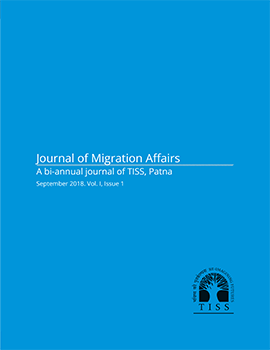Vol. VI
Issue: 1&2
Journal of Migration Affairs
Sept 2023 & March 2024
Article
- Home
- Article
Constrained Subjectivity: Narratives from Migrant Bonded Labourers in Bolangir, Odisha
The conceptual category of bonded labour has always attracted attention from scholars, who either term it a relic of the pre-capitalist mode of production or as one that perfectly coexists with the capitalist mode of production. Researches have focused their attention on the nature of the economy and the structural reasons responsible for the continuation of labour bondage. The questions of subjectivity and agency of bonded
READ MOREMigration and Education in Regions with a Culture of Migration: Observations from Kunkeri Village, Konkan, Maharashtra
The article explores the role of education in regions with persistent migration. Drawing from fieldwork conducted in Kunkeri village in Konkan, Maharashtra in 2017, the article contends that education serves as a preparatory tool for migration. The social and economic remittances of migrants encourage aspiring migrants to pursue education. In places with a culture of migration, such as Kunkeri village, a complex feedback loop
READ MOREMigrant Identity at the Intersection of Postcolonialism and Modernity
The post-Partition Indian state has become the place of residence for significant undocumented migrants from erstwhile East Bengal as well as present-day Bangladesh. The presence of these migrants has led to contentious questions of citizenship, residency, identity, belonging and legality. Migrants’ identity is caught between the dilemma of pre-existing cultural markers based on differences of language, religion, caste, and the modernist approach
READ MORE
Gender, Migration and Caste: Interrogation of Statist Representation of Care-workers in the Context of HIV/AIDS Discourse
This paper captures how the emigration of Dalit women for domestic work was represented as sexual slavery and deemed to be the leading cause of the spread of HIV in the Konaseema region of Andhra Pradesh. The anti-trafficking bandwagon was orchestrated at a juncture when the HIV infection rate was increasing among Dalits, providing legitimacy to regulative policies. The paper argues that the healthcare narrative ignores
READ MOREThinking of Migration through Caste: Reading Oral Narratives of ‘Displaced Person(s)’ from East Pakistan (1950-1970)
This paper studies the 1947 Partition of India, more specifically the Partition of Bengal, which took place along with the Independence of India and Pakistan. Discourses around the Partition— an event of enduring socio-political significance — have predominantly focused on the moment of rupture that compelled individuals as well as their families to cross the Radcliffe Line1 in search of a distant land touted as the safe haven. The word ‘safe’ here is loaded with significance.
READ MOREUnderstanding Life Work of Migrant Industrial Workers in Contemporary City of Global South: Bridging Urban Development with Precarity in Labour Market
The city of Faridabad, planned with Nehruvian vision in 1951, was built for the migrants who had arrived from Pakistan after the partition of India. The city was envisioned to provide work and housing to these migrants and hence large-scale industries were built along with housing colonies. Nehru had insisted on industrial development along modern lines, with proper workers’ quarters, to obviate the growth of slums (Jain 1998, 47-55).
READ MORE
Search
Current Issue
Previous Issue
Vol. V
Issue: 1&2
Journal of Migration Affairs
Sept 2022 & March 2023

